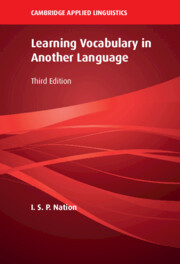Book contents
- Learning Vocabulary in Another Language
- The Cambridge Applied Linguistics Series
- Learning Vocabulary in Another Language
- Copyright page
- Contents
- List of figures
- List of tables
- Acknowledgements
- Introduction
- 1 The goals of vocabulary learning
- 2 Knowing a word
- 3 Teaching vocabulary and the roles of the teacher
- 4 Vocabulary and listening and speaking
- 5 Vocabulary and reading and writing
- 6 Learning vocabulary out of class
- 7 Vocabulary in specialised areas
- 8 Vocabulary-learning strategies and autonomy
- 9 Learning words from context
- 10 Word parts
- 11 Deliberate vocabulary learning from word cards
- 12 Finding and learning multiword units
- 13 Testing vocabulary knowledge and use
- 14 Designing the vocabulary component of a language course
- Book part
- References
- Author index
- Subject index
1 - The goals of vocabulary learning
Published online by Cambridge University Press: 02 June 2022
- Learning Vocabulary in Another Language
- The Cambridge Applied Linguistics Series
- Learning Vocabulary in Another Language
- Copyright page
- Contents
- List of figures
- List of tables
- Acknowledgements
- Introduction
- 1 The goals of vocabulary learning
- 2 Knowing a word
- 3 Teaching vocabulary and the roles of the teacher
- 4 Vocabulary and listening and speaking
- 5 Vocabulary and reading and writing
- 6 Learning vocabulary out of class
- 7 Vocabulary in specialised areas
- 8 Vocabulary-learning strategies and autonomy
- 9 Learning words from context
- 10 Word parts
- 11 Deliberate vocabulary learning from word cards
- 12 Finding and learning multiword units
- 13 Testing vocabulary knowledge and use
- 14 Designing the vocabulary component of a language course
- Book part
- References
- Author index
- Subject index
Summary
This chapter looks at what vocabulary and how much vocabulary needs to be learned. It is useful to use frequency and range of occurrence to distinguish several levels of vocabulary. Distinguishing these levels helps ensure that learners learn vocabulary in the most useful sequence and thus gain the most benefit from the vocabulary they learn. Making the high-frequency/mid-frequency/low-frequency distinctions ensures that the teacher and learners deal with vocabulary in the most efficient ways. High-frequency words are the most useful words of the language and should be learned first. There are 3,000 high-frequency words. These should be followed by mid-frequency words or specialised vocabulary. The mid-frequency and low-frequency words should not be taught but should be learned through extensive listening and extensive reading, along with the use of vocabulary learning strategies such as flash cards, word part analysis. and dictionary use.
Keywords
- Type
- Chapter
- Information
- Learning Vocabulary in Another Language , pp. 8 - 48Publisher: Cambridge University PressPrint publication year: 2022



